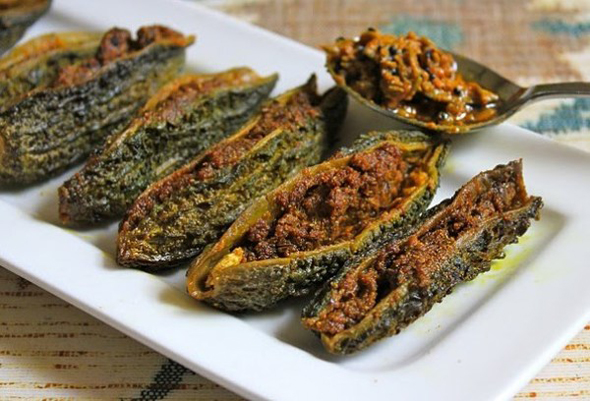Mama’s Punjabi Recipes: Bharre Karela (Stuffed Karela) with or without salt
This crinkly green vegetable with ridges is one that is deeply admired and loved in the Punjab for its taste and the way it can be made that both highlights its bitterness while bringing out the aroma and flavor of its fleshy shell.
Stuffing karele (bitter melons or bitter gourds) is the most authentic Punjabi way to prepare them and is the method which I learnt from my mother Biji, and her mother Bhabhi before her. It is a two-step process, first slicing and stuffing the karele with masala (spices) and then stir-frying them with small whole-onions, cross-sliced and similarly stuffed. To hold the masala together, often the vegetables can be wrapped and tied with thin cotton string which you may have to cut and discard while eating.
Karele originated in India and were carried into China in the 14th century though the Chinese variety is much bigger and not as bitter or tasty as the Indian one. Karele and the bitter juice extracted from the vegetable have many medicinal uses like treating stomach complaints, preventing malaria, reducing blood glucose and fighting cancer due to the antioxidants mostly in the green exterior skin. Some companies even sell gel capsules made of the karela extract.
Karele can be cooked many ways in the Punjab, each depending on the amount of time you want to spend and also the amount of bitterness that is to your taste. You can scrape the outer skin and make a burji (mash) of it or stuff it into a parantha (stuffed bread) or slice the karele and eat it like chips or stuff them with masala. Each method tastes good but you should them for yourself to judge.
Ingredients:
• 6 karele (bitter melons) choose green ones, not too yellow or too fat
• 2 tbsp tael (vegetable or olive oil)
• 1/2 cup saddi dahin (plain yogurt)
• 2 tbsp pani (water)
• 5 piyaaz (onions) – small ones
• Spices: 1tsp namak (salt), ¼ tsp mirch (red pepper), ½ tsp haldi (turmeric), 1 tsp amchoor (green mango powder) and 2 tsp sukha dhania powder (dried coriander seed powder)
Directions:
1. Wash the karela well then dry lightly with a towel.
2. Peel the karela and keep the peels aside for another day to use for other karela recipes.
3. Rinse the peeled karela and then make a deep slit lengthwise down the middle, but do not cut all the way through.
4.Peel the piyaaz and then cut them in a cross, but not all the way through.
5. In a cup mix the spices to taste and set aside.
6. Fry the karela open and with a small teaspoon, stuff the masala mixture in the slit. Tie the karelas with a short string to keep the masala in. (Another variation is to brown the karelas first without the masala, then slit then and fill them with the masala and tie them with a string too, if necessary.)
7. Pry open the slit onions and stuff them likewise with the masala mixture.
8. Heat the oil in a karahi (wok) over high and place the stuffed karelas in one by one. Brown one side then the other, careful not to spill the masala. Now remove the string if you had used to tie them.
9. Pour in the yogurt in a glass, add the water and mix well, stir and cover the wok for ten minutes.
10. When the yogurt-water has dried, add the onions, stir and cover again for 5 minutes.
11. Remove the cover and let the ingredients cook for another 5 minutes. Turn off the heat and let the dish cool down.
12. For best results, the karele should be a little crispy on the outside, but be careful not to burn them.
13. Enjoy with roti and some plain yogurt. This dish can keep in the fridge for a few days.
MAMA’S TIP OF THE WEEK: THREE TIPS FOR FASTER AND SALT FREE KARELE
Although karele are a tasty dish, they are often time consuming to make. One way to cut down on the preparation time is to use one large onion, peeled and sliced instead of using small stuffed onions. The onion slices spread out and make for an appealing dish. Another trip is to brown the small onions first then place the stuffed karele on top of them and then cover the wok until everything is tender. This makes sure that the karele do not get too brown or crispy. For those who want the benefits of karele, but are on a salt restricted diet, use amchoor and dahin instead as these can substitute for the salt flavor.

Shakuntla Malhotra is a skilled cook of Punjabi dishes made in the old-fashioned style that she learnt as a young woman in her ancestral home in Lyallpur, India (since renamed Faisalabad) before it became part of Pakistan after the Partition in 1947. People have often admired her cooking for its simplicity and taste that comes with each mouthful. Even in her late-eighties, she continues to cook daily and agreed to share her delectable Punjabi recipes for future generations.

